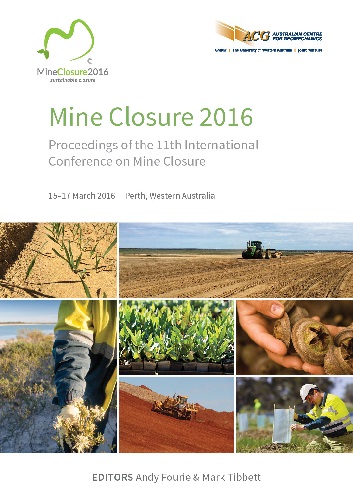Post-closure funding initiatives to facilitate custodial transfer and relinquishment of mining tenure

|
Authors: Mackenzie, S |
DOI https://doi.org/10.36487/ACG_rep/1608_30_Mackenzie
Cite As:
Mackenzie, S 2016, 'Post-closure funding initiatives to facilitate custodial transfer and relinquishment of mining tenure', in AB Fourie & M Tibbett (eds), Mine Closure 2016: Proceedings of the 11th International Conference on Mine Closure, Australian Centre for Geomechanics, Perth, pp. 419-422, https://doi.org/10.36487/ACG_rep/1608_30_Mackenzie
Abstract:
The aim of mine closure works is usually to minimise residual liability to enable the responsibility for land management to be transferred to a custodial authority. The accepted approach to relinquish mining tenure after closure works is to measure performance against agreed objectives and criteria over a period of time, to demonstrate success to key stakeholders. The relevant custodial authority may, however, be unwilling to inherit the responsibility for managing closed mines and ongoing closure liabilities in perpetuity. There are very few examples in Western Australia where a closed mine has been relinquished to the State Government in a coordinated manner. There are examples, however, where Governments have inherited legacy mines and associated closure liabilities, where the mine operator has been unable to meet their closure obligations. There are examples from around the world where mine operators have established long term, self perpetuating funding initiatives as a mechanism to facilitate custodial transfer of mining areas and coordinated relinquishment of mining tenure. Such initiatives can provide financial surety in the event of foreseen or unforeseen closure risks, provide for organisation and management of a custodial body, provide an ongoing benefit to the community or the environment, and can fund ongoing activities for a closed mine. Self-perpetuating funds and other mechanisms that buffer the exposure that a custodial authority has to residual liabilities and risks, in concert with demonstrated closure success, may encourage Western Australian regulators to more readily consider relinquishment applications for mining tenure. This paper reports on some of the long term funding initiatives that have been applied globally.
Keywords: lease relinquishment, custodial transfer, residual liabilities, self-perpetuating funds
References:
DITR (Department of Industry, Tourism and Resources) 2006, Mine closure and completion – leading practice sustainable development program for the mining industry.
DMP (Department of Mines and Petroleum) 2015, Abandoned mines policy – draft for consultation.
DMP & EPA (Department of Mines and Petroleum & the Environmental Protection Authority) 2015, Guidelines for preparing mine closure plans.
Grant, C 2007, ‘Developing completion criteria for Alcoa’s bauxite mine rehabilitation in Western Australia – an iterative process’, in A Fourie, M Tibbett & J Wiertz (eds), Proceedings of the Second International Seminar on Mine Closure, Chile.
Mackenzie, S, Topurua, A & Werror, M 2010, ‘The Ok Tedi mine; applying good practice initiatives in planning for the closure of a large and complex mine’, in A Fourie, M Tibbett & J Wiertz (eds), Proceedings of the 5th International Conference on Mine Closure 2010, Chile.
OTML (Ok Tedi Mining Limited) 2009, Benchmark study report — findings from three mine visits, unpublished report, prepared by S Mackenzie.
World Bank 2008, Guidance notes for the implementation of financial surety for mine closure.
© Copyright 2024, Australian Centre for Geomechanics (ACG), The University of Western Australia. All rights reserved.
View copyright/legal information
Please direct any queries or error reports to repository-acg@uwa.edu.au
View copyright/legal information
Please direct any queries or error reports to repository-acg@uwa.edu.au